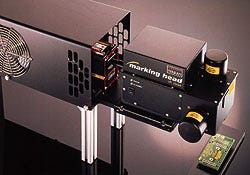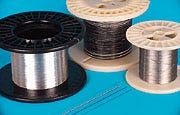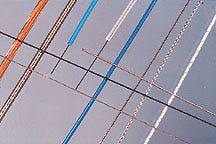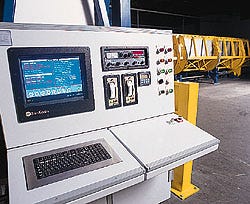Hotline
March 1, 1998
Hotline

Product Marking
Laser Marking System Simplifies Product Marking and Cutting
System uses all-digital technology
Laser marking has come of age in the last five years. Efficient CO2 lasers have replaced more expensive YAG lasers in many applications. The sealed CO2 lasers are more versatile and capable of marking a wider range of materials.
Synrad (Mukilteo, WA), a manufacturer of sealed RF-excited CO2 lasers, has introduced a laser marking system based on all-digital technology. The system makes the advantages of laser marking available to both large, high-end manufacturers and end-users doing low-volume custom work.
The system, which is sold as a partially assembled, self-contained kit of components, is designed to be easy to assemble and use. Devices can be reliably marked without fear of contamination. An operator using a desktop computer can mark a company logo on a wide range of materials, including plastics, wood, leather, glass, rubber, stainless steel, and titanium. Because the lasers are sterile, medical filters and other devices can be reliably cut and marked.
The laser can be expected to perform according to specification for 35,000 continuous hours. Because it is sealed, there are no consumable parts, and no maintenance is required. When the laser ultimately depletes its gas, it can be sent back to the manufacturer for a refill.
Using the laser is facilitated with system control software. Created in a Windows format, the system features pull-down menus, tool bars, and dialog boxes that guide the user through the set up and execution of virtually any laser marking application. While supporting thousands of True Type fonts, the software also can import more than 40 different file formats including BMP, GIF, TIF, JPEG, DXF, DWG, and PLT.

Wire Components
Multifilament-Drawn Wire Can Replace Solid Stainless Steel and Nitinol
Wire technology enables the mixing of different properties into single wire
As an alternative to stainless-steel and Nitinol solid wire, Cathguide Corp. (Miami) has designed a multifilament-drawn (MFD) wire that features high flexibility and torqueability.
The company's new wire technology allows the integration of two or more different materials (with different physical properties) into a single wire structure, thereby opening the door to new wire blends. When a wire blend of stainless steel and platinum-iridium is coiled, it provides a good distal tip because of the combined radiopacity and high tensile strength. In this case, a wire hybrid reduces manufacturing costs while providing a good balance between stiffness and suppleness, making the idea of a guidewire distal tip a reality.
 Some of the key properties of MFD wire that differentiate it from solid wire are fatigue strength, high flexibility, high torsional stiffness, and low resistivity. The company can incorporate radiopacity into small-diameter wires, eliminating the need for marker bands and radiopaque coatings.
Some of the key properties of MFD wire that differentiate it from solid wire are fatigue strength, high flexibility, high torsional stiffness, and low resistivity. The company can incorporate radiopacity into small-diameter wires, eliminating the need for marker bands and radiopaque coatings.
MFD wires are available in a wide variety of dimensions from combinations of metals such as stainless steels, nickel-titanium, and nonferrous and precious metals. Medical device applications include stents, guidewire cores and coils, pacer leads, stylets, flexible shafts, and snares.

Sterilization
Irradiation System Available for In-House Operations
On-site system can reduce shipping costs involved in sterilization
Recognizing a need in the device industry for more centralized sterilization operations, SteriGenics International (Fremont, CA) has developed an irradiation system that can serve both in-house and contract sterilization purposes.
The MiniCell system is suitable for device manufacturers with high-volume production schedules that want to maintain an in-house operation. According toSteriGenics, research shows that many device manufacturers ship their products several hundred miles to be sterilized. A MiniCell system installed in a customer's own plant could lower transportation costs, expedite turnaround, and reduce inventory requirements for that company.
All the long-standing benefits of gamma processing--simplicity, reliability, and the high flexibility of products that can be processed--are provided by the MiniCell. In addition, the issue of multiple-dose ranges is resolved by using a high-efficiency batch-type system to deliver target doses at any range without ever increasing process complexity in scheduling.
But the true advantage of the MiniCell system is the shield design and manufacturing method. The traditional poured-in-place-concrete design has been modified to virtually eliminate the construction contractor. The entire design is prefabricated and assembled before being shipped to the site.
You May Also Like


